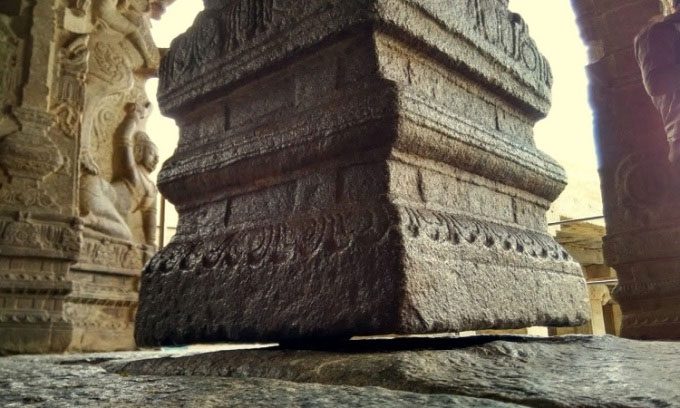The nearly 5-meter tall column hangs from the ceiling of the temple and does not touch the ground, leaving researchers puzzled about the construction methods and intentions of ancient builders.
At the center of Lepakshi village in Andhra Pradesh lies a wonder of ancient Indian architecture: a temple featuring a column that is completely suspended in the air. This intriguing phenomenon has turned the temple into a focal point for research, raising questions about the construction methods and intentions behind this column, according to Ancient Origins.

The suspended column at Veerbhadra temple. (Photo: Wikipedia).
The Veerbhadra Temple in Lepakshi is renowned for its intricate murals and sculptures dating back to the 16th century. However, it is most famous for its suspended column that seemingly defies the laws of gravity. The stone column, approximately 4.6 meters tall and adorned with exquisite carvings, appears to hang from the ceiling with its base barely touching the ground, allowing a piece of cloth or a handkerchief to fit through the gap.
Theories regarding the interlocking stones suggest that the column may consist of multiple stones perfectly balanced to create the illusion of suspension. However, researchers have not found any joints to substantiate this theory. Others speculate that the column could be partially hollow, reducing its weight and contributing to the appearance of levitation. Additionally, due to seismic activity in the region, many scholars believe that the unique design of the column might have been an intentional choice by the temple builders to enhance the structure’s earthquake resistance.
During the colonial period, a British engineer attempted to uncover the mystery behind the hanging column at the Lepakshi Temple. His attempts to shift the column resulted in it becoming misaligned. This incident caused part of the temple’s roof to collapse, but it also deepened the mystery surrounding the column, attracting more visitors and researchers.
The historical significance of the Lepakshi temple lies in its connection to the Vijayanagara Empire, one of the most prominent and influential empires in the history of South India. This empire was ruled by the Sangama and Saluva dynasties, flourishing between the 14th and 17th centuries. The construction of the Lepakshi temple during this period serves as a testament to the artistic, cultural, and religious achievements of the empire.


















































